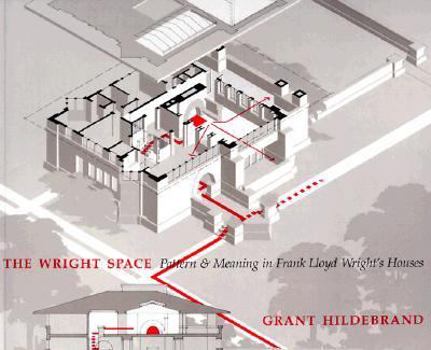The Wright Space: Pattern and Meaning in Frank Lloyd Wright's Houses
Select Format
Select Condition 
Book Overview
"In both early and late life," write Grant Hildebrand, 'Wright had an enormous number of domestic clients. ... They came to his drawing board in droves, and, having seen through to completion their adventure with him, they were, by and large, ecstatic about what they got. ...Many of these clients subsequently returned to Write for another house, and sometimes more than one.... "Yet few houses of equal fame have embodied more conspicuous faults. Many of Wright's plans defy reasonable furniture arrangements, many frustrate even the storage of reasonable and treasured possessions. In many cases sever problems afflict the architectural fabric: leaking roofs, unserviceable detailing, even structural inadequacies. ...There were problems of personality as well. ...Many of Wright's clients found him arrogant, careless, slow, and misleading, and were not by any means always amused by his temperament. And there are more vague and subjective difficulties, for the sheer power of these house as dramatic exercises in space and form can intimidate the...acts of ordinary daily life: how does on have a casual conversation in the Robie house dining room, or hang a cherished delicate picture in a Usonian?" If, then, these houses lacked so many of the usual aspects of satisfaction, why were they built with such profusion, and valued so highly? In this book thirty-three of Wright's domestic buildings, including all of the major houses on which his significance depends, are analyzed in detail in terms of their spatial characteristics. Fireplaces, seating, ceiling form, glazing, terraces, and roof overhangs are seen to follow a repetitive organization or pattern characterized by complementary juxtapositions of what the English geographer Jay Appleton calls "prospect" (a condition in which one can see over a considerable distance) and "refuge" (a place where one can hide). According to Appleton's theory of landscape aesthetics, this juxtaposition offers the ability to see without being seen (or to hunt successfully without being, in turn, successfully hunted) and thus, eons ago, had survival value. But such a condition must have been sought, originally, because it was intrinsically pleasurable to our species. Hildebrand finds a striking correlation in Wright's houses. Wright's pattern of prospect and refuge, to which are added similarly derived qualities of complexity and order, is show to be unique in domestic architecture to the degree to which it provides these preferred characteristics, suggesting why -- in spite of serious drawbacks -- his house were built and valued by so many clients. The text of the book is enhanced by photographs, plans, and by nine exquisitely drawn diagrams of key dwellings specially prepared by William Hook. Addressed to architects, landscape architects, architectural historians, environmental psychologist, anthropologists, philosophers of aesthetics, and the lay public with an interest in these subjects, The Wright Space, is essential reading for anyone who has ever lived in, looked at, or studied Frank Lloyd Wright's remarkable houses.
Format:Paperback
Language:English
ISBN:0295971088
ISBN13:9780295971087
Release Date:July 1991
Publisher:University of Washington Press
Length:192 Pages
Weight:2.37 lbs.
Dimensions:9.8" x 0.8" x 10.3"
Customer Reviews
4 ratings
Great Insights into Wright's Design Strategies Throughout His Career
Published by Thriftbooks.com User , 17 years ago
Superb book with great insights into recurring design strategies that extended throughout his career. As a Frank Lloyd Wright homeowner and architect with extensive Wright research and visits to his other residential projects, I can attest to the power of the design strategies articulated in this book. The book is well written with beautiful illustrations. The only shortcoming of the book is the contemporary examples in the back of the book which pale in comparison to the great architectural works by Mr. Wright. All things considered this book is highly recommended for Wright enthusiasts and architects.
Great Book
Published by Thriftbooks.com User , 17 years ago
This is a great book, giving insight into Wright'd designs. Good pictures of details of some of his houses that are not found in other sources and really nice 3D exploded views of some of the more important ones.
Rosetta Stone of Wright's Magic
Published by Thriftbooks.com User , 17 years ago
In this superb book, Hildebrand attempts no less than a definitive explanation of the method used by Wright to weave his architectural magic. Using the theories of "prospect and refuge" & "order and complexity" he sets out to establish what he calls the "pattern" that reveals itself in Wright's residential designs. Backed by detailed exposition, plans, diagrams and photos of specific examples he convincingly does just that: present the "pattern" that, to a greater or lesser degree, permeates Wright's work. Also covered are various detail items which are often, though with a lesser frequency, present. To the serious student of Wright's organic architecture, this book is an indispensible resource.
The Title is Accurate
Published by Thriftbooks.com User , 18 years ago
Nice book. The author has broken thru all the FLW complexity and clearly and methodically documented the Pattern and Meaning of FLW houses. The isomentric drawings are fantastic! I have been to several of his houses and I love them but could not pull together what the main concepts were. This book is also great for non-architects. I can now continue my passion of FLW research and see the "patterns". My goal is to transend the FLW concepts of "prospect/refuge" in architecture. My only complaint is that some of the black and white prictures are difficult to read. Color pictures would have been nice. Aside from this deficiency the book in my opinion is the best FLW available. I reccomend one read and study this book before visiting his works or reading anything else on FLW.





